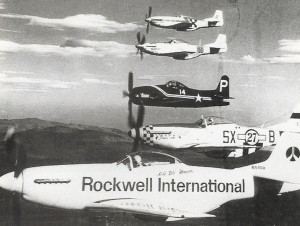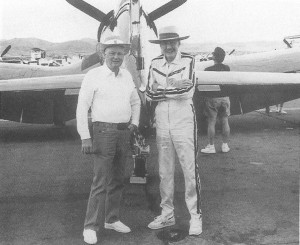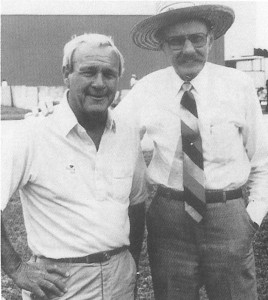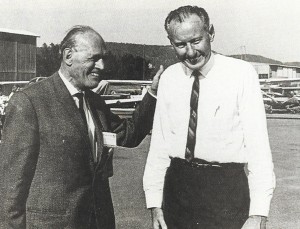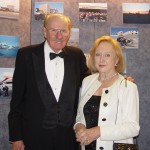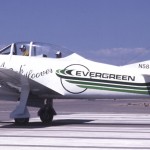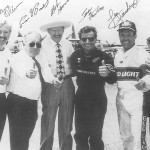By Di Freeze
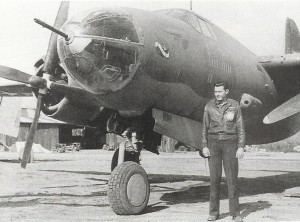
Bob Hoover was awarded the Distinguished Flying Cross for rescuing this Martin B-26 Marauder from the beach at the Messina Straits in Sicily, during World War II.
In 1984, the Abbotsford Air Show, held east of Vancouver, drew so much attention that traffic was bumper-to-bumper from the freeway to the airfield. In that traffic sat a popular performer who was behind schedule.
He watched the sky, judging his launch time by who was in the air. Suddenly, he rammed the car ahead of him. The other driver leaped from his car and raced to the pilot’s window.
“Damn it! I just bought this brand-new Lincoln for my wife,” he exclaimed. “Worse than that, now I’m gonna miss seeing Bob Hoover fly!”
Embarrassed, Bob Hoover introduced himself, apologized for the inconvenience and invited the couple to ride in his car. Soon, they were traveling through the VIP gate, towards the P-51 and Shrike Commander the legendary air show pilot would be flying that day. Hoover thrilled spectators that day, and continued to do so for years to come.
In more than 50 years of flying, Bob Hoover performed aerobatics in more airplane types, in more events, in more countries and before more people, than anyone in the history of aviation.
In “Forever Flying,” by R.A. “Bob” Hoover with Mark Shaw, Chuck Yeager refers to Hoover as the greatest pilot he’s ever seen and “a magician in the cockpit.” Astronaut Wally Schirra says Hoover’s “the finest acrobatic pilot we’ve seen in our lifetime.” Fellow acrobatic giant Leo Loudenslager says Hoover set the “standard of excellence,” and Barron Hilton compares the pilot in flight to “poetry in motion.” Jimmy Doolittle called Hoover the “greatest stick-and-rudder man who ever lived.”
This year, Hoover celebrated his 85th birthday. To honor his aviation achievements, Airport Journals presented him with the Living Legends Freedom of Flight award, at the fourth annual Living Legends of Aviation award ceremony.
An introduction to aerobatics
Robert A. Hoover was born on Jan. 24, 1922, in Nashville, Tenn. The youngest of Leroy and Bessie’s Hoover three children became infatuated with aviation when Charles Lindbergh made his historic transatlantic flight in 1927.
“I was just five years old,” he recalled. “I saw pictures and started building models.”
By high school, his love for aviation had grown to the point where he read everything he could about aviation, including newspaper clippings on Lindbergh, Eddie Rickenbacker and other aviation heroes of the day.
“Jimmy Doolittle was my idol,” he said. “I wanted to be just like him.”
A book by Bernie Ley introduced him to the world of aerobatics and gave instruction about how to perform routines.
“I studied the maneuvers until I knew every one by heart,” he said.
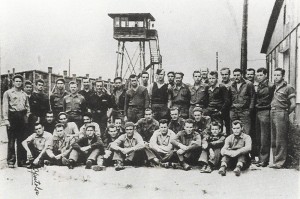
Bob Hoover (front row, fourth from right) and fellow prisoners held at Stalag 1, near Barth, Germany, during World War II.
Hoover would often ride his bicycle to Berry Field, 15 miles from his home, where the Tennessee Air National Guard flew the Douglas 0-38. One day, Roscoe Turner visited the field. By then, Hoover was familiar with stories of the pilot who often traveled with his lion, Gilmore. Turner’s flamboyance and attention to detail impressed Hoover. Seeking an opportunity to be near him, he wiped the windshield of Turner’s sleek Laird. In return, Turner let him sit in the cockpit.
At 15, Hoover began taking flying lessons. Each Sunday, he pocketed the two dollars he’d earned for 16 hours of sacking groceries and showed up at the airport for a 15-minute lesson in a Piper Cub. After almost a year, he finally had the eight hours needed to qualify for solo flight. But he had a problem.
“I was nauseated every time I got airborne,” he said.
When Hoover did finally fly solo, he was pleasantly surprised to find that without his instructor, the plane flew better and he didn’t get as sick. “Every time I found I could handle one maneuver, I went on to the next one, until I conquered the airsickness,” he said. “I did all sorts of aerobatics with airplanes that weren’t designed for it. I didn’t know any better, but I managed to do it without hurting them.”
He found out quickly that he loved to perform various routines, and was soon practicing harder maneuvers, like Cuban 8s, Immelmanns and hesitation rolls.
Joining the military
Hoover graduated from high school in 1940. On his eighteenth birthday, he joined the Tennessee Air National Guard. He was a tail-gunner trainee in the 105th Observation Squadron.
“I wasn’t eligible to go to the Air Corps flying school, because I hadn’t turned 21 and didn’t have the requisite two years of college,” he explained.
Still, some of the officers let him fly the dual-control Douglas O-38s, and he continued to buy flying time with the few dollars he earned in the Guard. In the meantime, World War II had begun. Although the United States hadn’t officially entered the conflict, the Tennessee National Guard lived up to the state’s reputation as the “Volunteer State,” and after requesting the privilege, went on active duty in September 1940. Hoover’s squadron was soon transferred to Columbia, S.C., where it was meshed into the Army Air Corps.
A change in regulations appeared to be the answer to Hoover’s dream of flying in combat and, ultimately, becoming an ace.
“They lowered the age to become a pilot from 21 to 18,” he said. “The squadron’s commanding officer gave me an opportunity to become a second lieutenant and a pilot in the Air Guard. However, I found out that if I went through his routine to become a military pilot, I would have an ‘S’ in my wings, which would mean ‘service’ pilot, not combat.”

Members of the X-1 team, responsible for breaking the sound barrier, included, from left, flight engineer Ed Swindell, backup pilot Bob Hoover, B-29 pilot Bob Cardinas, X-1 pilot Chuck Yeager, Bell engineer Dick Frost and Air Force engineer Jack Ridley.
Instead, he asked for an assignment for military flight training. Hoover reported for primary training in Helena, Ark., a small town south of Memphis, Tenn. It was December 1941, shortly after the bombing of Pearl Harbor.
On his first orientation flight in a Stearman PT-17, his instructor did a roll, and then asked him to try one. After Hoover completed a perfect roll, and then followed up with four-, eight- and 16-point rolls, as well as other advanced maneuvers, the instructor informed his commanding officer of the new pilot’s talent. Hoover was soon showing other instructors what he could do in the airplane, and the CO asked the 20-year-old to put on a 30-minute demonstration for the other cadets on graduation day.
Hoover thought he was finally on the way to being a qualified fighter pilot. But, he was sent to basic training at Greenville, Miss., and then to Columbus, Miss., for advanced twin-engine training. That meant he would eventually fly transports or bombers.
“I wanted to be a fighter pilot in the worst way,” he said.
Shorter pilots were likely to go to fighter training and taller ones to bombers and transports. At six feet, two inches, Hoover definitely had a problem, as did a short friend, who wanted to go to transports but had been given a fighter assignment. The two developed a plan and visited a sergeant in the personnel office.
“I slipped a 20-dollar bill to him and said, ‘He wants transports and I want fighters. Just switch those names, and everybody will be happy.’ That’s how I became a fighter pilot,” Hoover said.
Hoover reported to the 20th Fighter Group, stationed at Drew Field, Tampa, Fla. After training in the single-engine AT-6 trainer, he advanced to the P-40 and the P-39 Airacobra. He was soon putting the “Widow Maker” through a series of loops, rolls and spins.
When Hoover was transferred to the European theater, although he was just a sergeant, he was placed in charge of 67 pilots, both officers and enlisted men. He arrived in England in December 1942. His unit was sent to Atcham airfield, near the small town of Stone, north of London. There, they flew British Spitfires.
In a ceremony in December 1942, Hoover and the other enlisted pilots, who hadn’t received officer commissions, were designated flight officers, a rank equivalent to an Army warrant officer.
Africa

Bob Hoover (left) converses with German fighter pilot ace Eric Hartman, who shot down 352 Allied planes during World War II.
Two months after the Allies’ November 1942 invasion of North Africa, Hoover’s outfit was transferred there. He thought he was finally going to combat, and wasn’t happy when he found they were headed to a supply depot in Mediouna, assigned to a replacement pilots’ pool.
A few days after their arrival, the commanding officer, Col. John Stevenson, announced that a French major would be delivering and demonstrating a brand-new Lockheed P-38 Lightning. Although he had never flown the single-seater, twin-engine, twin-boom fighter before, Hoover had more twin-engine time than anyone else, and was told to put the plane through maneuvers after the initial display. Determined to outperform the major, Hoover put the Lightning through a series of low-altitude aerobatics.
“I was shutting down one engine and rolling into it, which is a no-no,” he said. “Then I started up again, and shut the other one down and rolled in that direction. Then I started to do things with just one engine. When I landed, the colonel reprimanded me in front of everybody. He said, ‘Young man, I want to see you in my office, immediately.’ I thought, ‘He’s going to ground me.’ When I knocked on the door, he yelled, ‘Come in,’ and by the time I got through the door, he was out of his seat and had his hand stuck out. He said, ‘Young man, I’ve never seen anything like that in my life! I have 300 hours in that airplane; I’d kill myself if I tried to do that!”
He officially grounded Hoover from that airplane. But at places including Oran and Oujda, Morocco, he became familiar with the new P-40 and the P-39, and tested Spitfires and Hurricanes. Although he was unhappy with his assignment, he later regarded it as a great learning experience.
“Flying so many airplanes gave me invaluable abilities,” he said. “I had every kind of emergency you could think of, and I learned to be quick in my thinking.”
He also became skilled at test-firing weapons, perfecting his talent until he could hit targets upside down and do four perfect consecutive round loops, accurately firing at targets at the bottom of each loop. During testing, Hoover had a couple of narrow escapes, but his most serious incident up to that point occurred in the Vultee Vengeance A-3 1, a light attack bomber. During a routine test flight, torching occurred; fire spewed out around the cowling next to the exhaust stacks each time the landing gear was lowered and the throttle was reduced to idle.
As Hoover tried to land, an explosion blew out the bomb-bay doors. The plane was completely engulfed in flames. Hoover told his mechanic to jump, but when he did, his parachute harness caught on the stowed .30-caliber machine-gun mount in the rear cockpit.
Hoover rolled the plane and shook the sergeant loose, but by that time, Hoover was too low to parachute. He added full power and rolled the plane from its inverted position, extinguishing the fire. Then he climbed to 10,000 feet, shut off the fuel supply and dead-sticked back toward the field. On final approach, the aircraft burst into flames. Hoover set it down, jumped out and ran.
The Distinguished Flying Cross
While training in Florida, Hoover had become good friends with Tom Watts, another P-39 pilot, who was from Globe, Ariz. By early 1943, Watts was with the 52nd Fighter Group, in Palermo, Sicily. Hoover hoped to get his chance to join the group when he met Major Marvin McNickle, on his way to taking over the 52nd FG, and shared his disappointment at not being in combat. McNickle said that if Hoover could get a transfer, he’d back up his request.
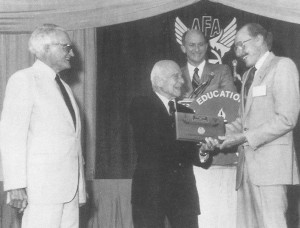
Former U.S. Senator Barry Goldwater (left) and Gen. James Doolittle present Bob Hoover with an Air Force Association award.
But Hoover was ordered to report to the 12th Air Corps headquarters in Algiers, which was organizing a ferry command. Their commander, Colonel Eppwright, had requested Hoover for his operations officer. Hoover was disappointed to find that he would be checking out pilots in airplanes and later, leading them in a North American B-25 Mitchell bomber to airstrips on the fighting front. He would also be bringing pilots back to Algiers to pick up planes that would replace those lost in combat.
After piloting a B-25 bomber to lead six P-40 fighters to Licata, following the invasion of Sicily, Hoover complained to a two-star general, Joe Cannon.
“I told him I’d just led these airplanes from Africa and about everything else I’d done,” Hoover recalled. “I said, ‘All I ever wanted was combat. I have enough time now to go home, but I don’t want to go home. I came here to fight!'”
Hoover also told him about McNickle’s invitation to join his group, if he could get a transfer. Cannon said he’d try to help. Hoover later discovered that Eppwright had stalled an order for his transfer.
“He told me I’d probably be shot down, and that he was just trying to save my life,” Hoover remembered. “He said that if I stuck with him, I’d be quickly promoted, and before the war was over, I’d have any assignment I wanted.”
Finally, Eppwright told Hoover he could leave, after he checked someone out in the B-25 to take over his responsibilities. The next day, he received copies of his transfer orders. Not wanting to give Eppwright a chance to reconsider, Hoover headed for Boco de Falco Air Base at Palermo for the B-25 check ride.
“Palermo had just fallen into our hands,” Hoover recalled. “I put my footlocker in the back end of that B-25, and I got in the pilot seat. These fellas said, ‘Where are we going?’ I said, ‘Palermo.’ When we got to Palermo, I took my footlocker out and said, ‘Fellas, you’re checked out. So long!'”
4th Fighter Squadron, 52nd Fighter Group
Hoover joined the 52nd Fighter Group in September 1943. Assigned to the 4th Fighter Squadron, his initial duties involved escorting Allied ship convoys carrying supplies. The newly designated combat pilot was disappointed that those excursions never resulted in dogfights with the enemy.
But Hoover became a hero when the squadron was offered a shot-up B-26 Martin Marauder, if someone could retrieve the plane from a short stretch of beach in the Straits of Messina. No one felt they could get the plane airborne, because it was in a narrow, obstructed area.
The challenge intrigued Hoover. He and a mechanic flew an L-4 reconnaissance plane to look at the bomber, which they found on a 1,000-foot crescent-shaped stretch of sand that had a 12-foot drop-off to the water at one end.
Hoover had studied manuals describing the plane’s capabilities and knew they would need to lighten the aircraft. Two days later, the mechanic and a crew of 10 men began removing the copilot’s seat, most of the instruments and everything else that wasn’t essential to fly the plane.
The recovery effort took more than a month. On takeoff, Hoover had less than 100 gallons of fuel. With about four feet of clearance on each side of 600 feet of steel matting now covering the sandy beach, and a 300-foot extension of chicken wire beyond that, he was able to lift the nose of the B-26 and head toward Palermo. He was awarded the Distinguished Flying Cross for his effort.
When orders came for the 52nd to relocate to Corsica, Hoover was told to fly an Italian Fiat to the new base. The vintage World War I aircraft had been discovered behind a damaged hangar, and Hoover and some of the base mechanics had restored the single-seat, high-wing monoplane. Traveling to Corsica in the aircraft was tricky, since he had only a float compass and no navigational aids. But he finally saw the southern tip of Sardinia.
“The Italian Air Force had surrendered, but these people didn’t have anybody to surrender to,” he recalled. “I landed, and they said, ‘We surrender.’ I said, ‘I can’t accept this. I have to be up in Corsica; all I’m asking for is some fuel and something to eat.'”
As Hoover neared the edge of the island, a flight of P-38s thought he was an enemy plane.
“They were going so fast, they couldn’t slow down to shoot at me,” he said. “I wagged the wings and pointed to the American insignia on the side of the airplane.”
It won’t happen to me
On Jan. 24, 1944, Hoover’s twenty-second birthday, he lost his roommate and best friend. After being shot down near the coast of Calvi, Corsica, Tom Watts had successfully bailed out of his Spitfire. But high winds dragged his parachute into a reef of rocks offshore, and he drowned. It wasn’t the first fatality for his band of men, but it hit Hoover the hardest.
A little over two weeks later, on Feb. 9, 1944, Hoover, who had been promoted to flight leader, took off from Calvi. He was heading a four-plane-formation of Spitfires on a mission to patrol the waters off the Italian and French coasts, between Cannes and Genoa.
Hoover was flying Black 3, a Supermarine Spitfire Mk. Vc, on a harassment mission to search and destroy enemy ships and trains. After Hoover and his fellow pilots had successfully destroyed a German freighter in the harbor near Savona, Italy, they flew back to base to refuel and then returned to patrol.

Bob Hoover performs his famous one-wheel landing at the first Reno National Championship Air Races and Air Show in 1964.
When Hoover caught sight of four German Focke-Wulf 190s, he called out their position. One of the FW-190s was on the tail of James “Monty” Montgomery, a friend who had been shot down a few months earlier and had spent three days in a life raft before being rescued. Hoover frantically called for Montgomery to break left to avoid gunfire. He knew he would need all the speed he could get, so he had to get rid of his aircraft’s external fuel tank.
“That’s high drag,” he said. “It really slows the airplane down. I had only 1,100 horsepower and was capable of doing only 215 mph. The airplanes I had engaged had capability of 350 mph. It’s like racing a Model T Ford with a Cadillac.”
But when Hoover pulled the handle that would release the external fuel tank, the handle came off in his hand. With the Spitfire’s superior turning ability now his only defense, he headed straight for a German fighter. He spat out a burst of .50 caliber gunfire and then saw billows of smoke streaming through the sky.
He had his first kill of the war, but had no time to celebrate. Montgomery had been hit, and Hoover watched his aircraft burst into flames. Now, two FW-190s were after Hoover. As he dove left, he noticed that his two friends had veered off and left him to fend for himself.
Not being able to release the external fuel tank seemed unlucky at the time, but now it made Hoover’s Spitfire so slow that the F-190s overshot him. When two more enemy aircraft turned in toward him, Hoover fired and hit one of the FW-190s. Just when he thought he might escape, shells hit his engine cowling from underneath. An enemy fighter had hit him with a high-angle deflection shot.
“I saw this airplane, 90 degrees out here, and I just ignored it,” Hoover recalled. “How could you ever get an angle shot like that?”
Hoover felt severe pain shoot through his lower body as another FW-190 closed in on him. The enemy pilot must’ve thought Hoover had no firepower, because he swooped under Hoover and pulled up in front of his nose. Hoover shot a burst of gunfire, but seconds later, the Spitfire’s engine exploded, and a ball of flames engulfed the aircraft’s nose.
“I called and told the British patroller, ‘I’m going down at sea, so alert the Dumbos (Walrus amphibian rescue planes) to start flying,'” he recalled.
He opened the cockpit, released his shoulder and seat straps, rolled the plane and pulled his parachute’s ripcord. The parachute didn’t open until three or four hundred feet above the water. His life vest, riddled with shrapnel, wouldn’t inflate, and when he hit the cold water, he felt immense pain in his lower body.
As he floated in the icy water, about 20 miles off the coast of Nice, France, he saw four Spitfires approach. When a group of FW-190s swooped down on them, one Spitfire was shot down and the others turned away. After four hours in the water, Hoover was picked up by a German corvette.
Prisoner of War

Captain Bob Hoover, Charlie Hillard, Art Scholl, Harold Krier and Bob Herrenden, at the Moscow Air Show, were members of the 1966 United States Aerobatic Team.
At Nice, France, German guards took Hoover to a local jail. Even though he was searched, he wasn’t given medical attention for his shrapnel wounds.
“Fragments of metal got into the backs of my legs and my private parts,” he said. “It wasn’t anything at that time; they were just flesh wounds.”
Hoover was transported to the Continental Hotel in Cannes, headquarters for German officers. There, to all questions, Hoover answered as he’d been taught: “Robert A. Hoover, flight officer, 20443029.” After days of lengthy, futile interrogation, he was transported to the southern coast of France, near Marseilles. There, he made his first of several escape attempts. When he was caught, he was confined to a dark basement cell.
He was then herded into a train compartment, and was soon heading north, toward Switzerland. Near the border, Hoover slipped out a small bathroom window and made his way along the tracks. He heard gunshots, and guards soon surrounded him.
When they arrived at the German Luftwaffe interrogation headquarters at Oberursel, north of Frankfurt, Hoover was put in solitary confinement. Over the next week, he would be questioned several times, but was still obstinate. One day, as he stood before a bullet-riddled cement wall, a frustrated German captain addressed him.
“You still have a chance,” the captain said, and Hoover responded, “Robert A. Hoover, flight officer, 20443029.”
“When they stood me against the wall, I thought, ‘Well, it won’t hurt for very long,'” he recalled.
As Hoover waited for the end, the captain said something to the Germans, who dropped their guns. Once back inside, the captain addressed him again, asking why he continued to be stubborn, since they already had information on him and knowledge of his aircraft from gun camera film. After repeatedly giving his name, rank and serial number, Hoover was returned to his cell. The Germans eventually did learn additional information about him, and Hoover was furious to know someone wasn’t able to hold his tongue.
Hoover became even more determined to escape. After one attempt, he was kicked repeatedly, resulting in head and facial injuries that left permanent scars. The Germans still hadn’t offered to treat his other injuries, which were now infected. Finally, an interrogator told him to drop his trousers. His swollen testicles and red, inflamed groin led the interrogator to believe Hoover had syphilis.
“I thought, ‘Maybe I do!’ I’d been having a lot of fun,” Hoover chuckled. “But it was actually blood poisoning. They didn’t treat me until I got to the main prison camp.”

L to R: Bob Hoover, with longtime friend and air show announcer Jim Driskell, and actor Cliff Robertson, who said Hoover performed aerobatic maneuvers like “a mad musician at the organ.”
The next day, Hoover and other POWs were stuffed into a boxcar in the marshaling yards near Frankfurt.
“The British were bombing the marshaling yards,” he said. “One of the British POWs had been the lead navigator on some night flights a few weeks before. He said, ‘I say, old chaps, it looks like we’ve had it. We’re the target.’ Everybody was praying; bombs were bursting all over the place. The guards went to the air raid shelters and left us there to die.”
Although those in his boxcar were unhurt, one car exploded, killing everyone inside. The prisoners finally arrived at Stalag Luft 1 in Barth. Double 10-foot barbed-wire fences surrounded individual compounds, while a similar fence enclosed the entire camp. POWs were aware that if they crossed a “warning wire,” they would be shot. Searchlights, mounted on the guard towers, illuminated the entire area.
An obsessive pursuit of freedom
Guards boasted that no one had ever escaped from Stalag 1, but Hoover and many fellow “Kriegies” continued their “obsessive pursuit of freedom.” He tried to escape at least 25 times, and as a result, spent a lot of time in solitary confinement.
Sometimes, while in confinement, Hoover talked through the walls to other prisoners. One was Col. Russ Spicer, who became an inspiration to his fellow POWs. Within earshot of German officers, he had given a bold speech about Nazi atrocities and reminded the prisoners not to get friendly with their captors.
“Russ was my hero,” Hoover said.
In early spring 1945, Allied Supreme Commander Gen. Dwight Eisenhower believed the war was almost over. He issued orders to POWs.
“He told the soldiers that were going out on missions to pass the word: POWs were not to escape after a certain date,” Hoover recalled.
By that time, 10,000 prisoners were held at Stalag I. It was a significant increase over the 1,200 who were there when he arrived. Despite Eisenhower’s directive, Hoover and others still devised ways to escape.
“I had been on an escape committee,” Hoover explained. “We’d been trying for so long. We were dedicated, digging tunnels and running at the fence. I once got caught hanging on the barbed wire, with dogs nipping at my feet. I really was scared, but I’d been working so hard at it, and I wasn’t about to quit.”
In April 1945, the Russians were getting closer, and German guards started deserting. Hoover had been a POW for more than 15 months. His partners in his latest escape scheme were Jerry Ennis, from the 52nd Fighter Group, and a Canadian airman named George.
“We found a board underneath one of the buildings,” Hoover said. “A bunch of people who had worked on the escape committee created a diversion. They started a fight on one side of the compound, so the guards were all looking over there. We ran out with this plank, put it up over the top of the fence and climbed out.”
The prison camp was located on a peninsula that jutted into the Baltic Sea. The three escapees went through the woods and gathered wood and grapevines for a raft.
“Jerry was on the raft,” Hoover recalled. “He held our clothes while we were in that cold water, pushing this thing across. We had to go about 2,000 feet, before we could get to the other side of the little inlet. When we got over there, the Canadian thought he’d be better off by himself.”
Hoover and Ennis spent the night at a deserted German farmhouse, under hay in the barn. The next morning, they stole bicycles from a small village.
“We kept heading west and landed in the middle of the Russian lines,” Hoover said. “They were still fighting the Germans. It was a slaughter.”
As Allies, Hoover and Ennis spent the night with a group of Russian soldiers. Ennis spoke fluent French and was able to communicate with some French-speaking Russians. The next day, another group of drunk, friendly Russian soldiers stopped them at a nearby village and invited them to a local church. Later, at another German village, a distraught elderly woman with a bloody cloth wrapped around her hand asked Hoover and Ennis if they were Americans.
“The Russians had cut off her finger to get her wedding ring,” Hoover recalled.
The woman led them to an area where they found many victims whose throats had been slit, then another spot where hundreds more had suffered the same fate.
“The Russians showed no mercy,” Hoover said.
While Hoover and Ennis traveled, they avoided revealing that they had been POWs.
“The Russians believed if you were captured, you were a collaborator,” Hoover said. “We knew the Russian philosophy by then, so if they asked what had happened to us, I would say, ‘We were shot down over Berlin, and we’ve been evading ever since.'”
The two men eventually ended up in a walled compound of farmhouses, where more than 50 people were staying. Most were French, who had been forced into labor camps when France fell to Germany and were now trying to flee the Russians.
“These people were all trying to get back home,” he said. “Since Jerry could speak French, they opened their arms to us.”
That night, as Ennis and Hoover slept in a hayloft, a tank broke through the wall of the compound.
“We could hear them speaking Russian,” Hoover remembered. “They were looking for people and anything they could take. They came into the barn, and I heard somebody scream. They were poking the hay with a pitchfork. When they finally came near us, we stood up and held up our hands. Jerry started speaking in French. Eventually, we found somebody who understood a little bit. We said we were Allies and had been evading, and we were trying to get back to our lines. They killed almost everybody else.”
Up, up and away?
When Hoover and Ennis left that area, they came across an abandoned Luftwaffe air base, just inside Germany’s border. The base was deserted, except for a few ground crew. As the men looked for an aircraft that might be flyable, they were surprised to be totally ignored. They discovered at least 25 Focke-Wulf 190s, but none were airworthy.
“They were all shot up,” Hoover said. “I finally came to one that had a lot of holes in it, but not in any of the vital organs.”
Although he had never flown a Focke-Wulf 190, Hoover had learned about the aircraft from a fellow POW, Gus Lundquist, who had gone to England to evaluate captured German airplanes.
“He talked one of the lead generals into letting him fly a mission, and was shot down,” Hoover said. “One day, I told him that I wanted to go to Wright Field after I got out, and he said, ‘I’m from Wright Field!’ When we’d have an opportunity, he’d sketch in the dirt where everything was.”
The men made plans to use the plane, but Ennis had decided not to fly out with Hoover.
“He never wanted to fly again,” Hoover said.
When a mechanic noticed the men, Hoover motioned him closer with a gun he’d acquired during their travels. They discovered that the German could speak French.
“Jerry told him that if he didn’t help me get airborne, he’d kill him,” Hoover said. “I got in the cockpit and the German helped me get the engine going. The fuel gauge was full and the engine ran up nicely.”
Realizing that the Germans could shoot at him as he took off, Hoover closed the canopy, opened the throttle full power and went across the grass field to the runway.
“I got airborne and pulled the gear up,” he remembered. “The stupidity of what I was doing hit me. I thought, ‘Here I am in a German airplane, without a parachute.'”
Since he was flying a plane with a swastika painted on the side, the Allies might take aim as well.
“It was overcast at about 4,000 feet,” he said. “I pulled up to the bottom of that overcast, so I wouldn’t be a target.”
Hoover headed north until he saw the North Sea.
“I didn’t have any maps or charts,” he said. “I knew that if I turned west and followed the shoreline, I would be safe when I saw windmills, because the Dutch hated the Germans.”
He followed the coastline to the liberated Zuider Zee in Holland. When he saw windmill, he looked for somewhere to get fuel.
“I had passed over some airfields that appeared to be deserted, but I knew that deserted runways were often mined,” he said.
He found a field and decided to land, but hit a ditch he hadn’t spotted from the air.
“I ground-looped it and wiped the landing gear out,” he said.
Hoover was disappointed.
“I wanted to get the plane back to England,” he said.
As darkness approached, he remembered seeing a road past some trees.
“I thought if I walked to that road, maybe a military vehicle would come along,” he said. “Just as I got ready to go into the trees, farmers with pitchforks came at me from all sides. They thought I was a German. They couldn’t speak English, so I kept pointing towards the other side of the trees, and they took me there. I stopped an English truck. I said, ‘I’m an American, but they think I’m a German!’ This fella said, ‘Get in here with us.'”
Hoover grins and says that later, everybody considered him a hero.
“People made it sound like a great escape, but the guards had deserted us,” he said.
According to Hoover, in the two weeks before the Americans liberated the camp on April 30, 1945, about 200 POWs actually escaped.
“General Eisenhower was correct,” he said. “We would’ve been safer to stay there. It was the dumbest thing I’ve ever done.”
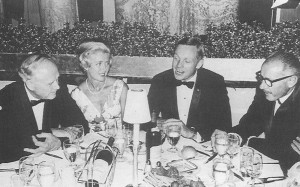
Bob and Colleen Hoover celebrate with Charles Lindbergh (second from right), the first man to fly across the Atlantic, and Neil Armstrong (left), the first man to land on the moon, shortly after Armstrong returned from space. Lindbergh was being inducted.
Hoover doesn’t know of anyone else who flew an enemy plane out of Germany. He didn’t talk about the incident for many years, even though a Nashville paper had reported his story soon after his return to the U.S. He finally talked publicly, 20 years later, at an air show performance in Redding, Penn.
“A security person came up to me and said, ‘A man over here says he was in prison camp with you,'” Hoover recalled.
The man was Jerry Ennis. After he took the microphone and told the story to the air show visitors, Hoover decided to tell his story and dispel exaggerations.
The journey continues
After hitching a ride on that English truck in Holland, Hoover hooked up with a former fellow POW.
“Nelson had gone over the fence in another direction,” he said. “We were both headed for somewhere near Le Havre, France, where the U.S. Army had established a series of camps. We were skin and bones. They’d get you back to your normal weight, give you a thorough physical examination and de-lice you.”
The men hitched rides on military vehicles and trucks, but decided they could get home sooner if they skipped the U.S. camp.
“We got on a train heading for Paris, because they let the military go for free,” Hoover said.
A gentleman in their compartment shared his food and a plan.
“He’d been in flight school training, but was now in the Merchant Marines,” Hoover said. “He said, ‘I’ll smuggle you on board my ship; we’re heading for the U.S.’ He smuggled us on, but the ship ended up going back to England!” Hoover said.
They hid in a compartment, but Nelson, feeling restless, left the compartment and went to the ship’s commissary. A suspicious intelligence officer followed him back to their hiding place. The officer thought Hoover and Nelson were German spies, and they were taken to the brig.
When their Merchant Marine friend found them, he assisted in their escape and helped them off the ship. With the help of Nelson’s friend in London, their luck turned.
“We lived pretty high on the hog,” Hoover said.
While in England, Hoover visited his brother Leroy, and found out that their mother was gravely ill. He and Nelson returned to the ship, now headed for New York. They explained their situation, and this time, were treated differently.
“They treated us royally all the way back,” Hoover recalled.
Back in the U.S.
Upon reaching the U.S., Hoover was sent to San Antonio, Texas, where he was debriefed. Then, he took a train back to Nashville. Col. McNickle, his former commanding officer in Corsica, was now assigned to the Joint Chiefs of Staff. He pulled some strings and had Hoover assigned to Wright Field.
“I immediately got an enrollment to the test pilot school,” Hoover said.
Hoover’s first assignment in the Flight Test Division at Wright Field was to perform compressibility tests on the Republic P-47 Thunderbolt and captured German and Japanese aircraft. Lundquist had returned to his pre-war test pilot job. One day, in the summer of 1945, the two men got into a forbidden dogfight near the field. Lindquist was in a Bell P-59 jet and Hoover was flying a Lockheed P-38 prop fighter.
When the men landed, Lt. Col. Bill Counsel, their no-nonsense CO, called them to his office. Hoover was grounded and given the job of typing operational orders, as a clerk. Lundquist left the program, rather than being reassigned. When Col. Albert Boyd assumed command of the Flight Test Division in October 1945, he decided that Hoover had been grounded long enough.
But Hoover wouldn’t stay in the air. Boyd clipped his wings after two harrowing flights in the Lockheed P-80 Shooting Star, the first operational U.S. jet fighter, and a test of wills.
Hoover’s tribulations with the P-80 included a September 1946 flight to Beverly, Mass. The jet turbines failed at 42,000 feet, forcing him to cut the engine. Ready to bail out at 7,500 feet, he realized he was close to Westover Airfield, in Chicopee, Mass. He was able to restart the plane, and with fore and aft fire-warning lights illuminated, the 24-year-old first lieutenant finally landed. He spent four days in the hospital, recovering from hypothermia and frostbite.
“The P-80’s skin was burned off, all the way from the engine back to the tail,” Hoover said.
Hoover also worked on a project with a test P-80, a jet powered by gasoline, instead of jet fuel or kerosene. The task was to find out if the jet presented a fire hazard. After determining it was safe, Boyd asked Hoover to use the P-80 to perform aerobatic maneuvers for Gen. Joseph McNarney, the supreme allied commander of the Mediterranean theater.
Everything went well during the first part of Hoover’s flight, but at 10,000 feet, the engine flamed out. As he tried to come in, the landing gear wouldn’t lock down.
“I knew I couldn’t make the runway,” he said. “I had come up over a highway. Cars were parked all along it. I decided I could get a wing between two cars. My main wheel crunched the hood of one car.”
With no air speed left, the aircraft stalled out.
“The impact with the ground forced the landing-gear struts through the wings and broke the fuselage back of the cockpit,” he said. “The nose was broken.”
The impact also jammed the normal and emergency canopy release mechanisms. Worried about fire, Hoover tried to force the canopy off by repeatedly pressing his shoulders and back against it. But the canopy was twisted and Hoover was trapped, until rescue teams arrived.
“My back was bothering me,” Hoover recalled. “They X-rayed me, but nothing was wrong. I just strained all the muscles in my back.”
Later that day, Boyd saw him in the cockpit of a P-51, ready to take off on another project, and they had an intense argument about Hoover’s physical status. The colonel commanded that Hoover get out of the plane, but he refused. When he repeated his command, Hoover demanded one good reason why he shouldn’t fly the plane.
“He grounded me,” Hoover said.
Two weeks later, McNickle, head of one of the labs, acquired Hoover temporarily to test aircraft. Boyd later returned him to the flight-test program.
The need for speed
In 1946, Hoover evaluated the Heinkel 162, a German jet fighter, before his assignment to a Messerschmitt 163 Komet program. The German rocket plane had reached nearly 600 miles per hour.
“They had gotten it up to .92 Mach number before hitting compressibility,” he said. “I was ready to fly with a rocket motor, but the power plant division decided it wasn’t worth the risk.”
By 1946, several aviators had died trying to break Mach 1, the speed of sound, including Geoffrey de Havilland Jr., a British pilot who attempted it in the Sparrow. The National Advisory Committee on Aeronautics (forerunner to the National Aeronautics and Space Administration) was pinning its hopes on the Bell Aircraft Company’s X-1, a bright orange, $6 million rocket-propelled craft, with 6,000 pounds of thrust. It would be dropped from the belly of a B-29 mother ship at 25,000 feet. Then, without fuel, it would glide back and land. A civilian test pilot, Chalmers “Slick” Goodlin, had made more than 20 flights in the aircraft, and had taken it to .8 Mach.
Engineers were concerned that the X-1’s structural integrity wouldn’t withstand the extreme stress loads likely to be encountered at Mach 1. Although it was considered a highly dangerous test flight, Bell Aircraft and NACA balked at Goodlin’s demand for a $150,000 payment upon successfully exceeding Mach 1. In May 1947, they started a search for a qualified military pilot.
Several pilots signed up for the mission. Told by Counsel that he was his choice, Hoover started preparing. Things changed, however, after Col. Boyd took over the flight test division, and called Hoover to his office, to inquire about an incident that had occurred months earlier. A P-80 had buzzed the Springfield Airport, upside down, and Hoover reluctantly admitted to the deed. Boyd said he respected his honesty, but added that he thought Hoover could also be irresponsible. He pulled him off the number one slot on the X-1 program.
Hoover, now the backup pilot, was devastated.
“I thought, ‘If I have to back up someone whose skills I don’t respect, the next several months are going to be miserable,'” he recalled.
Weeks later, Hoover was told of the selection of Chuck Yeager, a 24-year-old captain.
“I could hardly keep a smile off my face,” Hoover said. “I told Boyd, ‘He’s the greatest aviator I’ve ever known; you couldn’t have made a better decision.'”
Decades later, Hoover says Yeager is still “the best.”
“I respect and admire him,” he said. “We were fighting buddies in the air. He was the only person I had ever encountered that I couldn’t shoot down.”
After Hoover arrived at Wright Field in early fall 1945, he was assigned to a P-38 prop fighter. Yeager, a maintenance officer, was flying a Bell P-59 jet. Yeager would later recall that the two pilots started a dogfight in the air. As Yeager whipped his jet around, he pulled straight up into a vertical climb, and his plane stalled.
“I started spinning down, and that damn P-38 was spinning up. Both airplanes were out of control,” Yeager said.
They went by each other less than 10 feet apart, and decided to stop the fight.
“Yeager told me, ‘You can sure fly the hell out of that airplane,'” Hoover reminisced. “I said, ‘Look who’s talking! I’ve never met anybody as skilled as you.’ We became good friends.”
Number 2
Some people believed that Hoover and Yeager were chosen for the flight because they were among the most junior pilots in Wright’s flight test section and were expendable.
“I think the rumor may have been right,” Hoover grinned. “We were both only 24.”
He added that if things went wrong, their inexperience could be blamed. As backup, Hoover took part in all meetings with Yeager, flight engineer Jack Ridley and a handful of others on the program.
“I was as prepared to go as anyone could be,” Hoover said. “People jokingly said I was keeping my fingers crossed, but our friendship was stronger than that.”
Both men had to participate in NACA medical tests before the flight.
“Chuck and I had some real severe centrifuge testing to establish how much we could handle,” Hoover said. “The airplane was good for 18 positive G’s. That’s a lot more than we could handle physically.”
The men were locked in altitude test chambers and strapped to various centrifuges. The equipment exposed them to high G’s to determine their level of tolerance before blackout and unconsciousness. Once, the chamber technician forgot to open the valve on Hoover’s oxygen supply.
“I can’t express the helpless feeling of having your lungs locked in the middle of a breath, unable to inhale or exhale,” he said. “If Chuck hadn’t looked through the porthole window at that instant, I would’ve been asphyxiated.”
Muroc
Tests on the X-1 began in late July 1947, at Muroc, Calif., chosen because of its isolation and miles of dry lakebed. Walt Williams headed the NACA team, in charge of monitoring instrumentation aboard the X-1.
Hoover said Muroc resembled an Old West ghost town. It consisted of modest World War II barracks, a Spartan headquarters building and two hangars. A general store near the base offered necessities. Pilots wound down at Pancho Barnes’ Fly-Inn Bar and Restaurant, later to be known as the Happy Bottom Riding Club. The hotspot at the edge of Rogers Dry Lake also displayed constant reminders of the dangers test pilots faced; photos of pilots, who had died at Muroc, were hung behind the bar.
“Fatality rates were extremely high in those days,” Hoover said.
The first non-powered flights were in August. During those flights, after being dropped at 25,000 feet, Hoover would glide back and land on the lakebed. During the first glide flight, Bell X-1 project engineer Dick Frost flew low chase, while Hoover flew high chase (above 40,000 feet). As Yeager waited for Maj. Bob Cardenas, piloting the B-29, to drop him, Hoover, in the P-80, buzzed him.
“He flew by so close, he almost knocked me loose from the B-29,” Yeager said. “On my second glide flight, Hoover about shook me out of the airplane again. On my last glide flight, when I dropped out of the B-29, Hoover had already buzzed us and turned back in, so I turned back in to him.”
Their dogfight lasted down to the deck, and Yeager almost stalled the X-1. During his first powered flight, on the last day of August, Yeager reached .7 Mach. While diving for Muroc, he reached .8 Mach—a dive-glide faster than most jets at full power.
On October 5, his sixth powered flight, at .86 Mach, he experienced shock-wave buffeting for the first time. On his seventh flight, Yeager reached .94 Mach, but lost elevator effectiveness, due to the loss of pitch control, resulting in uncontrollability of the X-1. Analyzing the telemetry led to the realization that a shock wave had formed on the horizontal stabilizer at about .88 Mach. It was a problem, but Ridley suggested a successful fix.
For the next mission, the NACA team suggested a speed of .97 Mach. However, when they analyzed the flight data several days later, they discovered that Yeager had already officially flown .98 Mach, while testing the stabilizer. Yeager considered the possibility that he had already attained supersonic speed.
A few days later, following dinner at Pancho’s, Chuck and Glennis Yeager enjoyed a midnight horse ride. While racing back in the moonless night, Yeager’s horse hit a gate. He was thrown from the horse, cracking two ribs.
Yeager kept the accident a secret to all but those closest to him and the local doctor who taped his ribs. The next afternoon, he drove to the base. Unlocking the cockpit door required considerable strength. Ridley suggested a 10-inch piece of broomstick to lift and lock the door handle, and it worked.
On Oct. 14, 1947, Hoover was again flying high chase, when Yeager broke the sound barrier.
“Boy, he was whistling,” Hoover recalled. “He went by me as if I were standing still. He radioed Jack, ‘You’re going to have to get this Machmeter fixed. It just jumped, and then it went off the scale.’ As soon as Chuck said that, we all knew he had broken the sound barrier. Those on the ground heard what they said sounded like thunder in the distance.”
When Yeager broke the sound barrier, traveling at more than 700 mph (1.07 Mach), Hoover took the first photographs of the diamond-shaped shock waves from behind the X-1’s exhaust plume. It was a wonderful day for both of them.
“On our way down, I got back on his wing again,” he said. I said, ‘Pard, you got a steak dinner coming tonight at Pancho’s.'”
Barnes had told them that steak dinners would be waiting when their goal was reached. However, the celebration was cut short.
“Somebody came in and said, ‘This is top secret,'” Hoover recalled. “I said, ‘It’s too late! We’ve already been talking about it.’ He said, ‘From now on, don’t open your mouth.’ Of course, by then, the horse was already out of the barn.”
Another disappointment
One of Hoover’s greatest disappointments was that he never flew the X-1. A month after Yeager’s historic flight, Hoover had suffered serious injuries on an F-84 Thunderjet project. The engine had caught fire over the Antelope Valley.
“I was at about 40,000 feet,” Hoover said. “In those days, we had no pressurization. I was all iced up, so I couldn’t see out. No pressurization or heat. Both fire lights came on, and I knew the plane could blow up at any minute.”
Hoover prepared to eject, using the first ejection seat in America, copied from a German airplane he had tested. The aircraft was in a steep dive, at high speed, when he attempted to bail out, but the ejection handle failed. He unfastened his safety harness and oxygen hose and jettisoned the canopy.
“I was sucked out,” he said. “I went right into the tail, hitting the backs of my legs.”
When his face slammed into his knees, his rubber oxygen mask offered little protection.
“It knocked out a couple of teeth and busted up my jaw,” Hoover said.
He gathered his wits and pulled the parachute’s ripcord.
“I landed, crumpled up on the ground,” he said. “The wind kept the parachute inflated and it dragged me across the desert. I tried to pull the clamps, but it was too much force for me.”
Finally, sagebrush caught the bottom of the parachute, and it collapsed. A farmer found Hoover an hour later, and rushed him to Antelope Valley Hospital, in Lancaster. Because he was in the military, he couldn’t be treated there, and was ambulanced back to the base. Doctors put his broken left leg in an ankle-to-hip cast and his right leg in a brace. They later determined that his right leg was also broken. After six weeks of rehabilitation, Hoover resumed his test-pilot duties at Wright Field.
“I could fly again, but the X-1 was behind me at that point,” he said.
Changing course
Hoover left the military in December 1948, and joined General Motor’s Allison Division as a test pilot. His salary would be twice his military pay. That meant a lot to 27-year-old Hoover and his wife, the former Colleen Humrickhouse, whom he met on a blind date and married in September 1947.
At a starting salary of $850 per month, he tested Allison engines at Weir Cook Airport in Indianapolis, Ind. In 1951, he left to work for North American Aviation, located at Los Angeles International Airport. James H. “Dutch” Kindelberger headed the company; Lee Atwood was his second in command.
“I was with that company for 36 years, testing airplanes and demonstrating all over the world,” Hoover said.
He was one of six test pilots assigned to the engineering department, testing aircraft including the T-28 Trojan, FJ-2 Fury, AJ-1 Savage, F-86 Sabre and F-100 Super Sabre. In 1955, Atwood reorganized and expanded the company. Hoover was appointed director of customer relations and assistant to the marketing director. Soon after, Hoover became executive assistant to Gen. Austin Davis, who headed the aircraft divisions in Los Angeles; Tulsa, Okla.; and Columbus, Ohio.
“I had been promoted out of flight test, but Lee said that as long as I wished to fly, I could,” Hoover said.
The Aero Commander
In the mid-1950s, Hoover began flying North American Aviation’s civil and military aircraft at air shows. A decade later, shortly after the 1968 merger between the company and Rockwell, he was sent to Oklahoma City to evaluate Rockwell’s Aero Commander division. While touring the manufacturing operations, he found dozens of unsold aircraft.
“Rockwell had acres of them,” he said. “They were building one a month and losing $13 million a year.”
Dick Robinson, vice president of sales at that time, asked Hoover to develop an aerobatic routine that would attract attention to the airplane. Hoover thought it might be possible to duplicate his P-38 performances.
“The key was to see if I could perform the P-38 maneuvers within the structural design limits of the Aero Commander,” he said. “The P-38 was a fighter capable of pulling 7.33 G’s. The Shrike Commander, a twin-engine business aircraft, was limited to 4.4 as a utility design.”
The first public demonstration, during the annual National Business Aircraft Maintenance Show in Reading, Penn., went well, and more followed.
“Once those performances demonstrated the Shrike’s capability, production increased from one a month, to two and then eventually, to eight,” Hoover said.
Reno Air Races
During his final years at North American Rockwell, Hoover assisted Frank Jameson in overseeing corporate marketing and various field offices, and later served as director of special projects. In 1986, he left Rockwell International to join Del Smith’s Evergreen International Aviation Company, as corporate officer and board member.
In the early 1960s, Bill Stead asked him to help get an air race off the ground. Hoover was skeptical, but he consented. The first Reno National Championship Air Races and Air Show was held in 1964. Hoover served as the first official starter, in a P-51 Mustang, and continued that role for more than three decades.
In 1973, Hoover began flying aerobatic demonstrations in a Shrike Commander 500S (N500RA). Ten years later, he began flying both the P-51 and the Shrike for demonstrations.
People describing Hoover’s aerobatic performances usually included the word “incomparable.” He had many spectacular maneuvers, but over the years, audiences particularly enjoyed his signature “Dead Engine Energy Management Maneuver.” Performing from 3,500 feet above the ground, Hoover would dive the plane, with both engines shut off and propellers feathered, and then pull the nose up into a loop and complete an eight-point hesitation slow roll. Upon recovery, he’d maneuver the plane through a 180-degree turn before heading toward the runway. He ended by landing one wheel at a time.
“The Aero Commander and the Lockheed P-38 Lightning were the only planes I used for that maneuver,” Hoover said.
He said that the Sabreliner and the Shrike were probably the most challenging of all the airplanes he ever flew in air shows.
“Neither plane was designed for high-stress loads,” he explained.
For many years, Hoover performed in his trademark business suit and Panama hat. He abandoned the suit in 1984, after a near-catastrophic fire in Columbus, Ohio, and began wearing a Nomex fireproof flying suit.
Contributions and honors
Hoover’s contributions to aviation include two terms as president of the Society of Experimental Test Pilots. Setting the bar high for future presidents, he arranged to have Neil Armstrong, Buzz Aldrin and Michael Collins appear at the 1969 annual awards banquet, to receive a special award. The Apollo XI crew had recently returned from their mission to the moon.
He had also asked his longtime friend, the reclusive Charles Lindbergh, to be an honorary fellow and attend the banquet. Lindbergh had always declined before, but that year, he relented.
“When I brought him on stage, the place went wild,” Hoover recalled.
During his second term, Hoover arranged for record setters Jackie Cochran, Jacquelyn Oriole and Hanna Reitsch to be present at the 1971 banquet.
“They were three of the most famous woman aviators in the world,” he said. “The audience wouldn’t stop applauding.”
Over the years, Hoover has been honored by many organizations. In 1986, he received the Lindbergh Medal for lifetime achievement, and in 1988, he was enshrined in the National Aviation Hall of Fame. The International Council of Air Shows inducted him as their first Hall of Fame member in 1995.
“Let Bob Fly!”
Hoover said that during more than five decades of flying, safety was always his main concern; he always tried to set an example for other pilots. But in 1992, his flying came under Federal Aviation Administration scrutiny. The 70-year-old pilot had performed his usual acrobatic routine during the Aerospace American Air Show, in Oklahoma City. FAA inspectors Clint Boehler and James Kelln observed the show, and two months later, reported that Hoover’s flying skills had deteriorated.
Based on their report, the FAA required Hoover to take a battery of tests, designed to check his mental and physical competence. Although he passed all the tests and the FAA’s psychiatrist pronounced him fit, his privileges were revoked in 1993, on an “emergency basis.” He was told to surrender his medical certificate.
Renowned defense attorney F. Lee Bailey volunteered his efforts through three years of legal proceedings. Shortly before an administrative law hearing was to take place in Oklahoma City, Hoover passed several thorough exams. Dr. Brent Hisey, the neurosurgeon who performed the exams, and Hisey’s colleague, Dr. David Johnson, agreed to testify on Hoover’s behalf.
Hoover’s team was successful, but the National Transportation Safety Board reversed the judge’s decision. Unsuccessful appeals were made, all the way to the U.S. Supreme Court.
On April 13, 1994, the FAA informed Hoover he could no longer fly solo in the U.S. Hoover had flown 33 incident-free demonstrations since the investigation started, but the FAA’s decision would stand for 18 months.
Hoover was grounded from what he loved most. The FAA’s decision also began to take a financial toll. Sponsored air show performances had been his main source of income for several years, at about $1 million a year. But Hoover was far from alone throughout his predicament. He had the emotional support of his wife Colleen, son Rob and daughter Anita. Before Bailey took the case, he also had the support of “Friends of Bob Hoover,” a financial-help group, formed to aid his legal defense. Tom Poberezny, Chuck Yeager, Jim Brown and famed aerobatic pilots Leo Loudenslager, Sean Tucker and Steve Oliver spearheaded the group.
Hoover received letters of support from around the world. His supporters included friends from Tasmania, Australia, who were planning Sky Race ’94, the first pylon air race there. They had asked Hoover to start their races and perform daily.
Dr. Rob Liddell, director of aviation medicine for Australia’s Civil Aviation Authority, suggested Hoover take an Australian first class medical examination. He did and passed. Liddell then arranged for Hoover to take a commercial pilot’s license written exam and flight check. Hoover received a first-class commercial airline pilot rating, qualifying him to fly anywhere in the world—except the U.S.
In May 1995, Liddell set up a meeting with Dr. Jon Jordan, the FAA federal air surgeon. Hoover consented to submit to further tests, and Jordan agreed to have independent consultants review the results.
In the meantime, supporters continued to apply pressure on the FAA, writing thousands of letters and complaining to officials. In July 1995, thousands of flyers bearing the words “Let Bob Fly!” were posted at EAA AirVenture Oshkosh.
Several months went by, without a decision. Retired Northrop and Lockheed test pilot John Myers took the last step in helping him get back his medical certificate. The lawyer obtained Hoover’s documentation from Great Britain and Australia and forwarded it to FAA Administrator David Hinson. On Oct. 19, 1995, Hoover was told that his medical was being reinstated.
“For three years, Hinson never knew this case was a fraud,” Hoover said.
Hoover’s ordeal resulted in the 2000 passage of the “Hoover Bill,” which gives an FAA certificate holder the right to immediately appeal an emergency revocation to the NTSB. New final rules pertaining to the appeals of emergency revocations went into effect in June 2003.
Back in the air
Although he was back in the air, Hoover had lost valuable time, and he would soon have a further disappointment. His $20 million liability insurance dropped to $2 million.
“The insurance companies banded together and decided a new limit, because we lost a lot of air show planes and pilots about two years before,” he said.
Hoover’s family told him to keep flying, but he couldn’t take the risk. In April 2000, he flew his famous Shrike to Sun ‘n Fun, and then donated the plane to the Smithsonian National Air and Space Museum. The Smithsonian’s Stephen F. Udvar-Hazy Center was still under construction, so the plane was loaned to the International Sport Aviation Museum in Lakeland, Fla.
On Oct. 10, 2003, Hoover flew the aircraft to Washington Dulles International Airport, in preparation for the center’s December 2003 grand opening.
“I taxied right up, next to the Concorde,” Hoover said. “Jack Dailey said, ‘Do you realize your airplane is the only one we’ve ever let taxi into this building?'”
In 2003, Hoover co-founded Jet Fleet International with Capt. Eugene Cernan. The Los Angeles-based company sells products and services to private and corporate jet owners at discounted prices, by negotiating with vendors on behalf of its large membership base.
Speaking of his lifetime spent in aviation, Hoover said he was glad he picked something he absolutely enjoyed—beginning with his military career.
“I was excited about it every morning,” he said. “I could hardly wait to get up and find out what I’d be flying that day.”
He never lost that sense of excitement. No doubt that’s why every air show lover has a Hoover story. Even today, he remains a beloved figure, both in person and in legend.
- At the 4th Annual Living Legends of Aviation award ceremony, Chuck Yeager (left) presented the Legend Freedom of Flight award to Bob Hoover. Hoover was celebrating his 85th birthday.
- Bob and Colleen Hoover enjoy the 2003 Society of Experimental Test Pilots annual symposium and banquet.
- Chuck Yeager (left) and Bob Hoover share a laugh during the 1999 Gathering of Mustangs and Legends.
- Bob Hoover, shown in a North American T-28, left Rockwell International to join Del Smith’s Evergreen International Aviation Company in 1986.
- Bob Hoover stands on the wing of his famous P-51 Mustang, Ole Yeller.
- Bob Hoover stands on the wing of his famous P-51 Mustang, Ole Yeller.
- Attorney F. Lee Bailey (second from left) and air show aerobatics stars Steve Oliver (left), Sean D. Tucker (center), Leo Loudenslager and Dave Weimann (right) show support for Bob Hoover, during his dogfight with the FAA.
- Air Force Thunderbirds demonstration team members salute Bob Hoover, before he starts his performance in the P-51.












